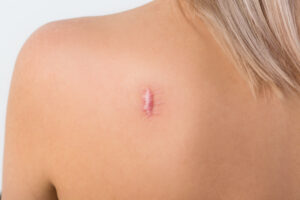 This was in the “Best of” Plastic and Reconstructive Surgery papers for 2021. “Keloids: Which Types Can be Excised without Risk of Recurrence? A New Clinical Classification.”
This was in the “Best of” Plastic and Reconstructive Surgery papers for 2021. “Keloids: Which Types Can be Excised without Risk of Recurrence? A New Clinical Classification.”
They discuss how genetically Africans, Asians, and Native Americans have higher incidence of keloids. Melanocytes seem to be crucial in keloid development. (Albinos do not develop keloids). Because keloids cannot spontaneously regress like hypertrophic scars do, there are all sorts of treatments: steroids, 5FU, cryotherapy, radiation, lasers. Keloids have not been traditionally divided: where on the body? how long have you had it? it is hard or soft? So when we say the rate of recurrence is 19-45%, is that true for all keloids?
The team looked at 387 keloids. They classified the Keloids into 4 categories:
- Fresh nodular (continuously growing) keloids. These had a 30% recurrence rate after surgery. They used a steroid injection at onset. Earlobe keloids had the lowest recurrence rate after complete excision with negative resection margins.
- Superficial spreading “butterfly” keloids. Treated with steroid injection only, and only in the growing margins. This will reduce the height, but not the width. There is no reason to cut out the scar.
- Mature, non-growing or burned out keloids, treated with surgical excision, using a steroid injection when you see a recurrence occurring. These had a low recurrence rate of 4.5%
- Transition keloids cannot be classified immediately. These are various types, which fit into different classes
- *EARLOBES have 5 morphologic patterns: sessile, single nodular, pedunculate, multinodular, buries, and mixed. They found cutting these out has a low rate of recurrence.
Traditional treatments for keloids include surgical removal (frequently followed by immediate radiation or steroid injections), but there is the worry it may stimulate additional collagen synthesis, causing recurrence and creating a keloid even larger than the original one. For this reason, sometimes the scar is cut out leaving a rim of the keloid tissue to prevent stimulation, though this has been shown not to work.
Steroids and 5FU injections are used to suppress the inflammatory process during wound healing, as they inhibit collagen and fibroblast growths. The response to steroid injections is variable, with 70-90% regression, but 33-50% recur after 1-5 years, and there are issues with skin thinning and blood vessels called telangiectasia. Combining the steroid with 5FU shows better satisfaction. And then there is the question of when to inject. Some studies indicated applying it later improved treatment efficacy.
Radiation is also used. But a systematic literature review of 25 studies of surgery combined with radiation showed to significant difference between that and steroid injections.
Their findings?
The importance in preventing keloid recurrence is a careful radical surgical removal, not leaving positive resection margins. The remnants of keloids from prior surgery may regrow over time. They get routine histology reporting of keloid excision margins.
They also comment that many of their patients remembered a bacterial infection as the cause of their keloid.
The researchers recommend more differentiation between “fresh” and “mature” keloids to help treatment further.
My thoughts?
Keloids are tough. I think it is helpful to see you need to completely cut out the keloid so it doesn’t come back, and interesting to note that many of the keloids start as bacterial infections. So those who are prone, if they have issues with acne or folliculitis where they shave, they need to be aggressive with cleaning and antibiotics if needed. Prevention of keloids are key. It was also interesting to see that radiation did not help over steroid injections.
